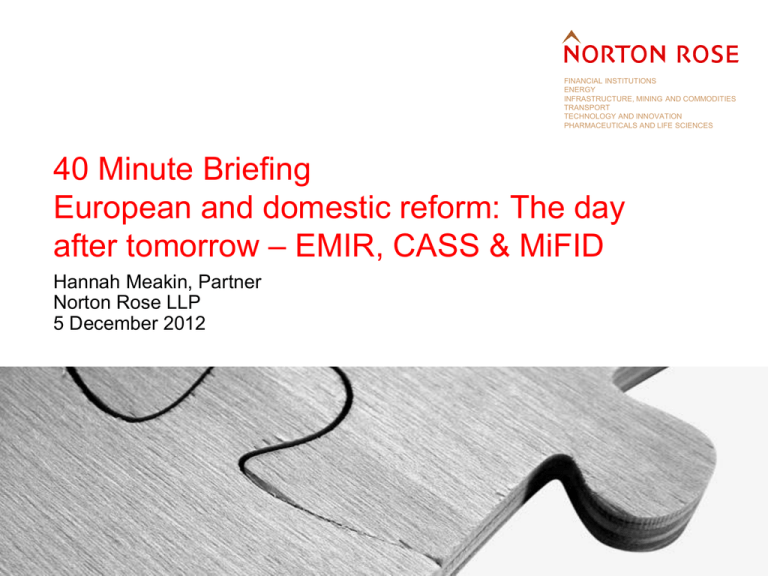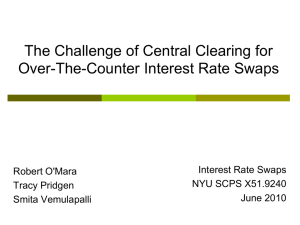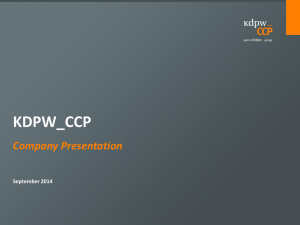Financial services 40 minute briefing entitled `CASS
advertisement

FINANCIAL INSTITUTIONS ENERGY INFRASTRUCTURE, MINING AND COMMODITIES TRANSPORT TECHNOLOGY AND INNOVATION PHARMACEUTICALS AND LIFE SCIENCES 40 Minute Briefing European and domestic reform: The day after tomorrow – EMIR, CASS & MiFID Hannah Meakin, Partner Norton Rose LLP 5 December 2012 Introduction and timing Introduction • Timing • The latest on client clearing • Proposed changes to CASS • Impact on trading structures Timeline: EMIR, MiFID and CASS August 2012: EMIR enters into force EMIR MiFID 20 June 2012: Council of the EU begins publishing compromise proposals Late Q1 2013: Most RTS expected to enter into force European Parliament considers legislative proposals in plenary and refers them to ECON for reconsideration 2526 October 2012 Q4 2013: First clearing obligations expected to apply 2013 December 2012: Final rules on Part I CP12/22 expected 1 January 2013: Handbook rules in PS12/20 will come into effect From 1 January 2014 at the earliest: Reporting obligations for credit and IRS apply 1 July 2015: Trades start to be reported to ESMA where there is no trade repository Implementation of MiFiD II legislative proposals (at the earliest) 4 December 2012: ECOFIN meeting 2012 CASS First half 2013: ESMA expected to consult on collaterisation From 1 July 2013 at the earliest: Reporting obligations for credit and IRS apply First half 2013: FSA feedback on Parts II and III CP12/22 expected 2014 2015 The latest on client clearing A quick reminder of the obligations in EMIR Clearing • OTC derivatives entered into or novated that are listed on ESMA register must be cleared through a CCP • Applies to transactions between: – Two financial counterparties – A financial counterparty and an in-scope non-financial counterparty – Two in-scope non-financial counterparties – A financial counterparty or an in-scope non-financial counterparty and a third country entity that would be subject to clearing if established in EU – Two third country entities that would be subject to clearing obligation if established in EU provided (a) contract has direct, substantial and foreseeable effect in EU or (b) if necessary and appropriate to prevent evasion of EMIR • Very few exemptions • Kicks in on date obligation takes effect but some contracts existing at that date will need to be front loaded • All OTC derivatives that are not CCP cleared Risk management • Timely, electronic confirmations, portfolio reconciliation, portfolio compression and dispute resolution • Daily marking to market or marking to model • Timely and appropriate exchange of collateral, segregated where possible • Hold capital to manage risk not covered by exchange of collateral Reporting • All derivatives concluded and any modification or termination must be reported to a trade repository • No later than the following working day • Can delegate but must avoid duplication • Backloading provisions A typical clearing structure B Central Counterparty S B S Clearing Member (principal) Clearing Member (principal) Back-off contract Back-off contract Clearing Agreement B S Asset Manager (agent) S Fund (principal) B Clearing Agreement S B Counterparty( principal) Client clearing: Segregation and porting In order to comply with clearing obligation, a counterparty must: – Become a Clearing Member of a CCP or a Client of a Clearing Member – Establish indirect clearing arrangements with a Clearing Member CCPs and Clearing Members must offer both: – Omnibus client segregation – Individual client segregation Requirement to distinguish involves recording in separate accounts and not netting across accounts, not exposing assets in one to losses in another CCPs must allow Clearing Members to open further accounts for their Clients CCPs and Clearing Members must disclose levels of protection and costs - must be reasonable commercial terms CCPs must commit to trigger procedure for porting - if Clearing Member becomes insolvent and Client so requests, transfer Client positions and assets to another agreed Clearing Member CCPs can actively manage their risks by liquidating positions and assets if this cannot be done within a pre-defined timeframe Client collateral can only be used to cover positions held for relevant Client account and any surplus on a Clearing Member default should be returned to Client or, if not possible, to Clearing Member for relevant Client account Omnibus segregation: Books and records Clearing Member books and records Client 1 CCP books and records Client 1 Clients 1, 2 + 3 Client 2 Client 2 Client 3 Client 3 Clearing Member Clearing Member Individual segregation: Books and records Clearing Member books and records CCP books and records Client 1 Client 1 Client 1 Client 2 Client 2 Client 2 Client 3 Client 3 Client 3 Clearing Member Clearing Member Client clearing: Porting CCP Cleared Contract, Rules, provision of collateral Clearing Member Back-up Clearing Member Back off contracts, Clearing Agreement, CCP mandated documentation, provision of collateral Client OTC Counterparty OTC derivative trade Porting of positions and assets takes place on Clearing Member default Omnibus and individual segregation compared Omnibus Individual Assets and positions recorded in separate accounts Distinguish positions and assets of Clients from those of Clearing Member Distinguish positions and assets of one Client from those of any other Client and from Clearing Member No netting of positions recorded on different accounts Means positions of one Client in an account can be netted with positions of other Clients in same account Positions of Client in that account can be netted Assets covering positions in one account are not exposed to losses related to positions in another account Means assets of one Client in an account can cover positions connected to losses on positions of other Clients in same account so fellow Client risk exists Assets of Client can only be used to cover that Client’s positions in that account so no fellow Client risk Excess collateral Margin in excess of Client’s requirement can be held at Clearing Member level Margin in excess of Client’s requirement must be ported to CCP and not held by Clearing Member Porting Likely to be more difficult Should be more likely Detailed risks depend on exact set-up and operation of accounts Choice of accounts: Questions Omnibus or individual account at CCP level? Client money protection or not at Clearing Member level Title transfer or security interest Possible choice of sub-pool if omnibus client account with client money protection Clearing Member must offer both May offer variations – e.g. if omnibus, may be choice of net or gross margining Client money currently incompatible with porting but will change N/A if Clearing Member is a bank N/A if margin if provided for on title transfer (and not retail) Cash or securities? Clearing Member may need to transfer to CCP so will need right of use if security interest Sub-pools are subject of FSA Consultation Objective is to facilitate porting in net margined omnibus accounts Indirect Client clearing Client to honour obligations of Indirect Client to Clearing Member – contract between three parties CCP will, on Clearing Member’s request, maintain separate records and accounts to enable Client to distinguish its positions and assets from those of Indirect Client If Clearing Member wants to offer indirect clearing: CCP Clearing Member Client – Implement individual and omnibus type accounts in its books and records – Establish procedures to manage a Client default including: – Indirect Client – Mechanism for porting positions and assets to an alternative Client or the Clearing Member – Allowing for prompt liquidation of positions and assets and return of balance to Indirect Client Publish terms and manage risks of arrangement If Client wants to provide indirect clearing: – It must be an authorised credit institution or investment firm or equivalent third country entity – Offer Indirect Clients choice of individual and omnibus type accounts and inform Indirect Clients of risks including details of porting arrangements If Client defaults, information about Indirect Client is given to Clearing Member Proposed changes to CASS Changes to CASS required by EMIR Existing client money regime undermines porting FSA has consulted on amendments to CASS (CP12/22) – – Final text expected in December 2012 Clearing Member must notify CCP but need not obtain trust acknowledgements Clarifies that a firm can hold excess client money in a client transaction account if required to do so by law On Clearing Member failure, balance on client transaction account is not part of general pool – it is: – Client money is pooled on firm failure Inconsistent with transferring to back-up Clearing Member Ported to back-up Clearing Member Returned to Client Returned to Clearing Member Client may lose its client money regime protection if back-up Clearing Member is not subject to CASS Clearing Member discharges client money responsibilities if What about title transfer? EMIR should not prevent the use of title transfer collateral arrangements between a Clearing Member and Client or Clearing Member and CCP EMIR will require Clearing Members to offer choice of omnibus or individual segregation even if business is done on a title transfer basis Clearing Members will need to have separate client transaction accounts at a CCP for positions held for its title transfer Clients and those held for any client money Clients If the firm becomes insolvent then when this money is returned by the CCP it is not client money for the purposes of CASS but, in accordance with EMIR, must be held by the firm for the account of its Clients Consequences of Clearing Member default CCP: 1. Port positions and margin 2. Return balance to Client Individual client account Defaulting CM: Defaulting CM: Client: Client money Not part of notional pool 3. Return balance to defaulting Clearing Member Omnibus client account Notional client money pool Not Client money ‘For account of clients’? Full sum minus costs Sum rateable to client money entitlement Sub-pools idea for EMIR Consultation period just closed – Feedback expected first half 2013 Objective is to facilitate porting in net margin omnibus client accounts Porting will require clients to double margin to cover back-up CM’s exposure to each of them On Clearing Member default, there may be client money at Clearing Member level that would facilitate porting but which will be pooled Firms could keep client money that relates to such an account but is not passed on to a CCP in a separate pool, which is used to facilitate porting on firm’s default Pre-default, CASS applies separately to each sub-pool and to general pool (eg. segregation, reconciliations, diversification obligations) On default, client money can be transferred to a CCP or back-up Clearing Member Optional Advantages and disadvantages Sub-pools for EMIR From FSA CP 12/22 Requirements for sub-pools Notify FSA 3 months ahead of establishing, amending and merging Sub-pool terms – to identify beneficiaries and where client money is held Disclosure document – to make Clients aware of risks arising from pool and other Clients sharing in it – Description of purpose, whether Clients are retail or not, business line to which it relates, advantages and risks to which Clients are exposed, how firm expects sub-pool to be distributed on failure, how beneficiaries can be identified, statement that beneficiary of pool will have no claim or interest to any other pool unless it is also a beneficiary of that other pool and (if relevant) statement that sub-pool is intended to facilitate porting – Provide to Client and get written acknowledgement and consent – Provide copy on Client’s request and give 3 months notice of material amendments and mergers, allowing Client to terminate relationship Provide sub-pool terms and disclosure document to FSA on request Possible introduction of sub-pools for wider purposes FSA asking whether it should roll out sub-pools for other investment businesses Could allow firms to decide whether and how many sub-pools FSA recognises firms may get more benefit from creating bespoke arrangements – Operating multiple pools will be costly and not all firms and clients will see benefits in segregating along different lines – But potential lack of incentive given costs Could mandate segregation: Retail v non-retail clients – Retail cash would not be exposed to risks taken by wholesale Clients and may allow more rapid distribution from retail pool as fewer contentious issues Margined v non-margined – Volatile trades so riskier and likely to be more contentious issues Alternatively, FSA could incentivise use of sub-pools by requiring firms to make Clients aware of risks with general client money pools and subpool options on the market Sub-pools for wider use From FSA CP 12/22 Wider CASS review: Achieving better results • Discussion paper on wider review – FSA aims to produce consultation paper in first half 2013 • Objectives: – Improve speed of return – Reduce market impact of insolvency – Achieve greater return of assets • Review of special administration regime and broader issues arising from MF Global being undertaken by government in parallel • Current regime prioritises accuracy over speed – FSA questions whether this is right balance • Should it be different for retail and wholesale Clients? • Wider review will also cover matters raised in supervisory work: – Banking exemption – Alternative approach – Trust letters Wider CASS review: FSA’s ideas Achieving greater returns Require firms to hold a buffer in client bank accounts OR seek private sector mutual insurance An alternative approach requiring firms to hold an equivalent amount to the approximation of the monies at risk in house accounts in client bank accounts Prioritising certain categories of Clients Speed of return Reducing market impact • Dislocate primary pooling event and firm failure to provide option of selling business rather than immediate pooling • Get Client’s pre-consent to transfer their assets Regular Client statements detailing balances and any right of use Placing more emphasis on the firm’s records of account segregation Limiting use of exclusions or requiring greater transparency Establishing lock-in or cooling off periods to reduce switching in days leading up to failure Incentivise operating via mandates Insolvency practitioners liquidating all assets and shortfall shared equally Looking at inappropriate use of term deposits by some firms Other changes to CASS: The mandate rules Clarifies mandate rules: – – – Any means which a firm obtains in written form from (and with the consent of) the Client and subsequently retains, and which gives the firm the ability (without the client’s further involvement being necessary) to control the client’s assets or liabilities by: – – – – • Do not apply where firm holds client money or assets Do not apply to operator of regulated collective investment scheme Do not affect duties of another firm that holds client money or assets Giving instructions to another person who holds an account for the Client Giving instructions to another person who is responsible for holding the Client’s money Giving instructions to another person who is responsible for holding the Client’s assets Giving instructions to another person so that the Client incurs a debt or other liability Confirms that firm must establish and maintain adequate records and internal controls in respect of its use of mandates Other changes to detail of CASS and CMAR Classification and oversight does not apply to firms that only Impact on trading structures Brokerage structures • Ultimate trade obligations • Initial trade obligations • Means of getting trade executed Sponsored and Naked Access CCP Exchange Direct Electronic/ Market Access Executing Broker Introducing/Agency Broker Give-up Agreement Client Clearing Broker Trading venues Regulated Markets (RMs) - Non-discretionary execution of transactions - Managed by market operator -Operating is not an investment activity or service Systems that bring together third party trading interests and result in contracts Multilateral Trading Facilities (MTFs) - Non-discretionary execution of transactions - Operating is an investment service but can be operated by market operators - Few conduct of business rules apply Organised Trading Facilities (OTFs) (Commission proposal) - Discretion over execution of transactions - Investor protection, conduct of business and best execution requirements - Cannot trade against proprietary capital - Operating is an investment service but can be operated by market operator Organised Trading Facilities (OTFs) • Broadly defined: all types of organised execution and arranging of trading which does not correspond to RM or MTF • Includes: – Broker crossing systems which execute client orders against other client orders – Systems eligible for trading clearing-eligible and sufficiently liquid derivatives • Does not include: – Facilities where there is no genuine trade execution or arranging taking place in the system, such as bulletin boards, entities aggregating or pooling potential interests or electronic post-trade confirmation • There are two different levels of discretion: – When deciding to place an order on the OTF or to retract it again – When deciding if, when and how much of two or more client orders it wants to match within the OTF • Text now clarifies distinction between multilateral and bilateral systems • Parliament proposed to limit to bonds, structured finance, emissions allowances and derivatives and Council has followed • Clarification that simultaneous matched principal trading is permitted subject to strong conflicts management – UK govt agrees • Council text is more restrictive on what is permitted: – Prior express consent of Client needed – Not derivatives declared subject to mandatory trading No more OTC derivatives trading? Mandatory on-platform trading for derivatives G20 commitment to have all standardised OTC derivatives traded on exchanges or electronic platforms Derivatives that are subject to clearing obligation in EMIR which: – Are traded on at least one RM, MTF or OTF – Are considered sufficiently liquid to only trade on these venues ESMA also has an own initiative power to identify derivatives for this purpose: Unclear whether this allows ESMA to include instruments which are not CCP cleared but this appears so Must be traded on a RM, MTF, OTF or certain third country trading venues which Commission deems to be equivalent and where third country provides equivalent recognition for EU trading platforms Same scope as EMIR in relation to counterparties: – Trades between financial counterparties and in-scope non-financial counterparties – Trades between an EU captured entity and third country entities that would be subject to EMIR – Trades between third country entities that would be subject to EMIR if they were established in the EU where their transactions could have a direct, substantial and foreseeable effect within EU and this is necessary to avoid evasion – Excludes certain intra-group transactions Algorithmic trading and direct electronic access •Parliament amendments: – Now a definition of high frequency trading and sponsored and naked market access – Firms using a high frequency trading strategy must store raw audit trail of any quotation and trading activities performed on any trading venue – Market makers must enter into a written agreement with the trading venue including terms and conditions on liquidity provision – Investment firms shall not provide sponsored and naked market access to a trading venue – Even more requirements on platforms for systems resilience, circuit breakers and electronic trading • – – Points to note Many of these provisions reflect ESMA Guidelines which are already effective UK govt thinks more evidence of impact is needed and is concerned about requirement to provide liquidity at all times • – – – – Council amendments: New high frequency algorithmic trading definition Market making need only be carried out during a specified portion of venue’s trading hours except under exceptional circumstances. Market making firms shall take into account sound operational, commercial and risk management practices, as well as liquidity, scale and nature of specific market and the characteristics of instruments traded New provisions for firms that engage in algorithmic trading pursuant to a market making strategy – I.e. a strategy, when dealing on own account, that involves porting firm, simultaneous two-way quotes of comparable size and at competitive prices relating to one or more financial instruments on a single trading venue or across different trading venues, with the result of providing liquidity on a regular and frequent basis to the overall market Pegasus: MiFID OTC Oracle: EMIR Disclaimer The purpose of this presentation is to provide information as to developments in the law. It does not contain a full analysis of the law nor does it constitute an opinion of NRLLP on the points of law discussed. No individual who is a member, partner, shareholder, director, employee or consultant of, in or to any constituent part of Norton Rose Group (whether or not such individual is described as a “partner”) accepts or assumes responsibility, or has any liability, to any person in respect of this presentation. Any reference to a partner or director is to a member, employee or consultant with equivalent standing and qualifications of, as the case may be, Norton Rose LLP or Norton Rose Australia or Norton Rose Canada LLP or Norton Rose South Africa (incorporated as Deneys Reitz Inc) or of one of their respective affiliates.











